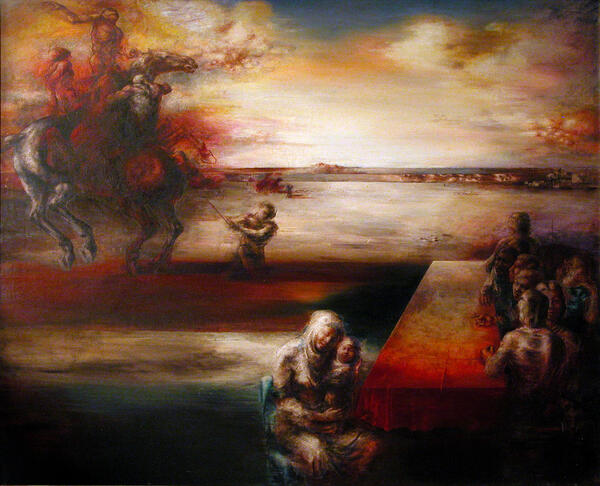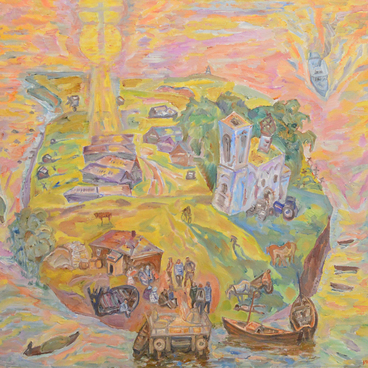Yerbolat Tulepbaev is a talented Kazakh painter. His art is one of the interesting phenomena of contemporary visual art. Tulepbaev is a painter of international renown in whose art both national Kazakh traditions and Pan-European culture were reflected.
Celebrating the Newborn is one of the key works in the artist’s career. The theme of motherhood and uneasy entering of a newborn child into the world is a basis of the work’s concept. Its subject is a moment of celebration the baby’s forty days. According to the Eastern custom, when the baby is forty days old, his parents organize the celebration, where all the visitors should give the presents and express their wishes to the baby.
To the right at the long table is a young woman keeping the baby, on the other part of the table is a row of guests. The celebration takes place in the open space with the steppe going out to the horizon on the background. The fascinating scenes of equestrian events give expression and internal tension to the work. For the artist the idea of deepened and symbolical apprehension of the general ethic features and the national culture is important. The philosophical narration and epic wideness combined with the intimacy of the plot became the characteristic feature of the work’s graphic structure.
Breaking the space, changing it intentionally, displacing the accents and uniting reality and fantasy in one space, applying to the symbolistic means were the methods present in the art of the young generation of painters working in the 1980s. In the painting Celebrating the Newborn the scenes of equestrian events and fighting are on the background and, at the same time, we can think of them as a real action at the celebration. At the same time the people sitting at the table seem too calm, frozen, and distracted as if they were in some timeless space. Perhaps the quite realistically painted images are nothing but a dream. And when we realize that, probably, it’s just a creature of a painter and our own creature as well, we invent the following events of the newborn baby’s life ourselves. The competition scenes turn into the symbol of the difficulties the baby is about to go through.
Tension of the palette (flashes of lake colour and dark emerald colour) create polychromatism and alarmingly pulsating light-grey space, and add polysemanticism and dramatism to the painting.
Significance of Yerbolat Tulepbaev’s art goes far beyond purely national context and can legitimately be called one of the remarkable phenomena of contemporary European art.
Celebrating the Newborn is one of the key works in the artist’s career. The theme of motherhood and uneasy entering of a newborn child into the world is a basis of the work’s concept. Its subject is a moment of celebration the baby’s forty days. According to the Eastern custom, when the baby is forty days old, his parents organize the celebration, where all the visitors should give the presents and express their wishes to the baby.
To the right at the long table is a young woman keeping the baby, on the other part of the table is a row of guests. The celebration takes place in the open space with the steppe going out to the horizon on the background. The fascinating scenes of equestrian events give expression and internal tension to the work. For the artist the idea of deepened and symbolical apprehension of the general ethic features and the national culture is important. The philosophical narration and epic wideness combined with the intimacy of the plot became the characteristic feature of the work’s graphic structure.
Breaking the space, changing it intentionally, displacing the accents and uniting reality and fantasy in one space, applying to the symbolistic means were the methods present in the art of the young generation of painters working in the 1980s. In the painting Celebrating the Newborn the scenes of equestrian events and fighting are on the background and, at the same time, we can think of them as a real action at the celebration. At the same time the people sitting at the table seem too calm, frozen, and distracted as if they were in some timeless space. Perhaps the quite realistically painted images are nothing but a dream. And when we realize that, probably, it’s just a creature of a painter and our own creature as well, we invent the following events of the newborn baby’s life ourselves. The competition scenes turn into the symbol of the difficulties the baby is about to go through.
Tension of the palette (flashes of lake colour and dark emerald colour) create polychromatism and alarmingly pulsating light-grey space, and add polysemanticism and dramatism to the painting.
Significance of Yerbolat Tulepbaev’s art goes far beyond purely national context and can legitimately be called one of the remarkable phenomena of contemporary European art.



